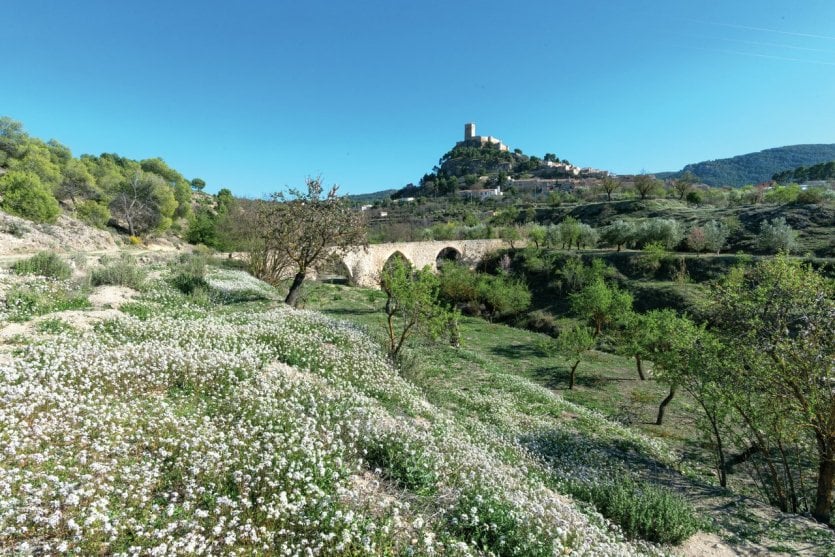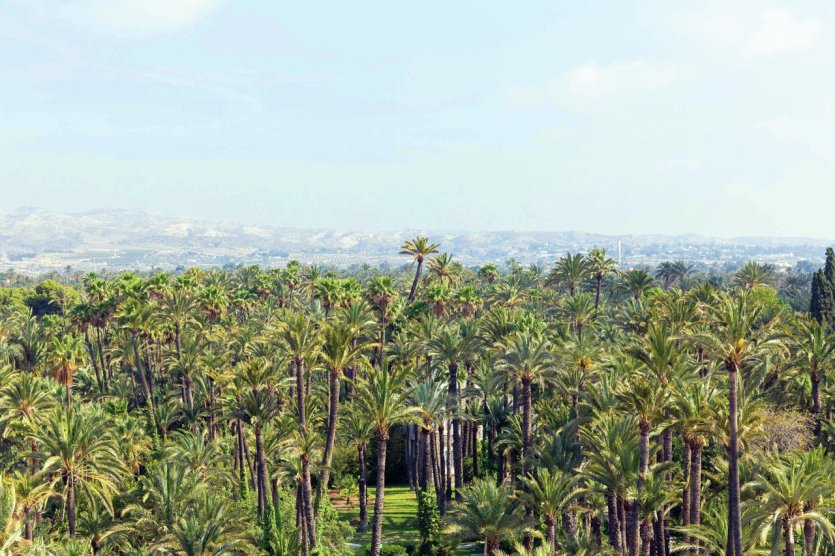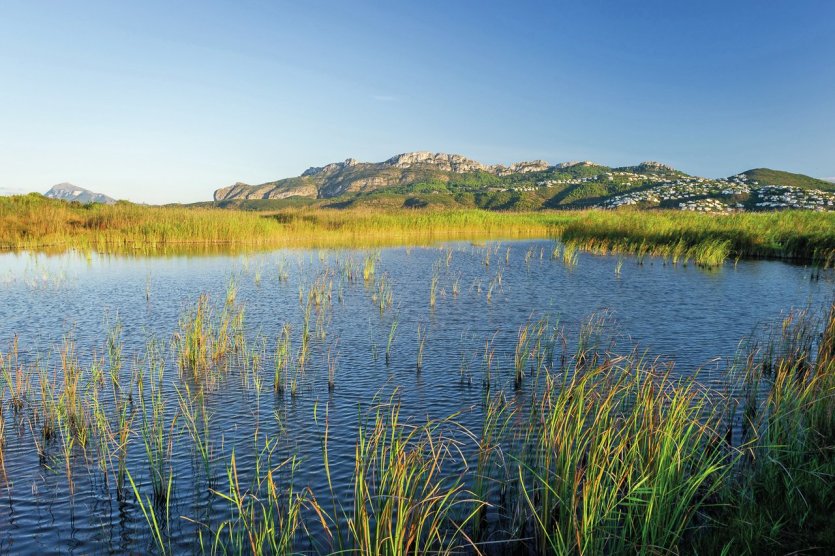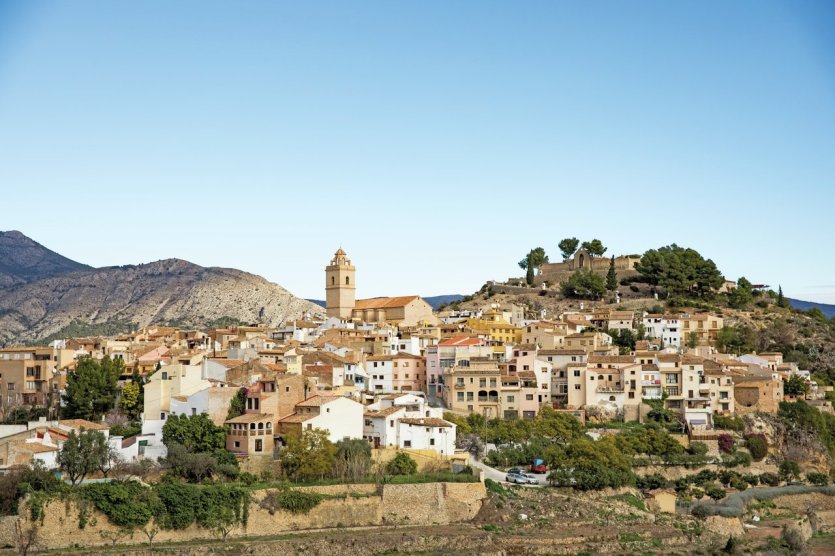
Less known than its coastline, the interior of the province of Alicante is full of assets that justify the discovery. First of all, the beauty of its natural landscapes where you can enjoy the blooming of the almond and cherry trees in the spring. You can also explore its winding streets, its medieval fortresses and its modernist heritage. Not to mention the taste of a specific gastronomy.
The Vall de Gallinera

Between the mountains of Les Solanes, del Admirante and Foradà, this valley includes eight villages: Benirrama, Benialí, Benisivá, Benitaia, La Carroja, Alpatró, Llombai and Benissili. To discover it, we will hike to the castle of Benirrama, a medieval fortress destroyed by an earthquake, but offering superb views of the province of Alicante. In the spring, you can enjoy the beautiful spectacle of the cherry blossoms.
Biar

The imposing 17th century castle dominates this small village, located at 650 meters above sea level, which for a long time served as a border town and a natural passageway from Castile to the Mediterranean. Climbing the castle will give you the opportunity to enjoy panoramic views of the remains of the city wall and the Casco Antiguo. Before going to another emblematic viewpoint of the place, its aqueduct with arches, a 70 m long work dating from 1490.
The Serra Mariola

Mountains, valleys, ravines in all shades of green, the presence of hermitages and fountains that encourage rest, air impregnated with the aromas of rosemary, sage, lavender, thyme ...: this is the program for a discovery of this area of the province of Alicante, declared a Natural Park since 2002. You can enjoy the song of a bird, the run of a hare or the quiet walk of a partridge as you walk along the many paths that cross it.
Busot and the caves of Canelobre

This charming little town in the province of Alicante is home to a treasure, the Canobre Caves, whose vaults are 70 meters high, the highest in Spain, and whose stalactites and stalagmites are more than 100,000 years old, earning one of its rooms the nickname "Sagrada Familia". In the city, you can enjoy its museum of ethnic music, or prefer a hike in the surroundings, cycling the old via ferrata.
Castell de Guadalest

The village of Guadalest is accessed through an archway carved into the stone. In the background is the 14th-century Arab castle, from which you can enjoy the view of the mountains of Xortà, Serrella and Aitana. The site is exceptional, which has earned it a place in the group of the most beautiful villages in Spain. In terms of gastronomy, we will taste theolleta de blat (a bean-based stew), the main dish of the valley.
Villena

The capital of the county of Alto Vinalopó does not lack assets. From its castle of the watchtower, a fortress of Arab origin among the most impressive in the province of Alicante, you will enjoy superb views. Then, all around this castle, its historical center, which has been classified as a historic-artistic complex, will allow you to discover its treasure: 59 gold, silver and amber objects (from the Bronze Age) presented in its archaeological museum.
Alcoy

Held at the end of April, the Moros y Cristianos festival inAlcoy is the most famous in the Valencian Community. And since the township is at the confluence of three rivers, it is also known for the great bridges it has, such as the Sant Jordi bridge and the Canelajas viaduct. Finally, we will discover the buildings that have earned it a place on the European Route of Modernism, reflecting its pioneering position in the textile industrial revolution.
Eix/Elche

With more than 200,000 trees, the palm grove of Elche is a UNESCO World Heritage Site and gives a special silhouette and atmosphere to the whole city. You can discover it by bike or by walking through the heart of the village, the "huerto del cura", the priest's orchard. You can also visit the Basilica of Santa María, where the Misterio de Eix, a World Heritage Site, is performed every year. And a few kilometers from downtown, six beaches surrounded by dunes and pine trees.
Pego

In the heart of the Marina Alta, you can appreciate the medieval heritage of this small town in the province of Alicante by stopping at the Casa de la Cultura, which houses a museum of contemporary art and a museum of ethnology, and by walking to the emblematic Plaza del Ayuntamiento. As this city is part of the Marjal Pego-Oliva Natural Park, you will be able to enjoy its unique landscape, deeply marked by dunes, rice fields and rivers.
Polop

Its 12th century castle crowns the silhouette of this large village in the Marina Baja in the province of Alicante, and the main part of its wall can be seen. Your steps will then lead you to the Plaza de los Chorros, where you will find no less than 221 water sources from the Terrer and Garrofer springs. And hiking enthusiasts will find pleasure in the Monte Ponoig, which rises to almost 1,181 meters and is covered with pine and olive trees.


